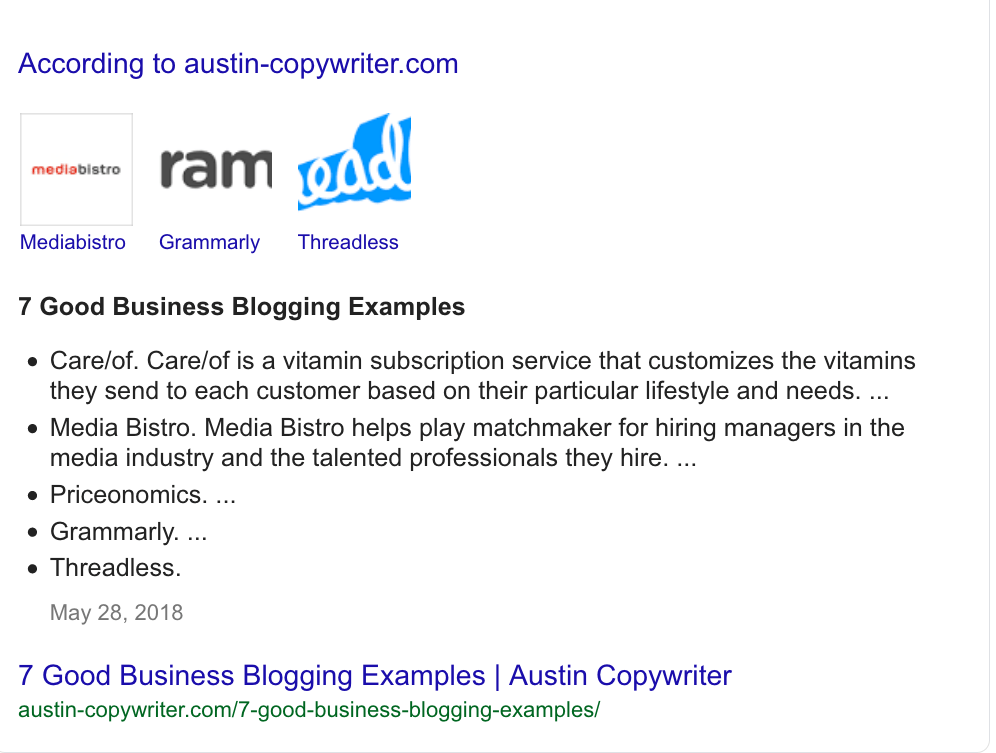As a freelance content marketing writer, I’ve been tasked with writing about a lot of different industries over the years. But even though I’ve never worked as a cybersecurity specialist or a customer service agent, I’ve managed to write blog posts about those subjects (and many others) that speak to an audience of experts.
How is it possible for a freelance writer to learn enough on a new topic to write knowledgeably?
The short answer is research.
But that word covers a lot of territory. Doing effective research can take a number of forms.
First Things First: Onboarding Research
For each new client, this starts with onboarding research.
I ask clients to provide me with internal resources that help me get up to speed on their brand and industry, such as a style guide and buyer personas. I have an onboarding questionnaire I send that asks for information like target audience details, their top competitors, industry publications they like and trust, and examples of pieces they like the style of. I spend time reviewing their website to understand how they talk about the brand and product. And I read a number of their blog posts to get a feel for the typical writing style and the kinds of subjects they cover.
All of that happens before I start on research for the first blog post. Some writers have a minimum work requirement for new clients to account for how much time goes into onboarding research. (I don’t personally, but 100% understand why other writers do. The time commitment is a lot).
5 Smart Research Strategies for Better Blog Posts
Once I have a strong bearing on the brand, product, and industry, I can get into the research needed for the first blog post itself. In my experience, there are five main research strategies that lead to high-quality blog posts.
Strategy 1: Use a mix of online research and internal resources.
This is probably the most obvious research strategy available, and it’s the one I personally use the most often. But that doesn’t mean it’s always the easiest.
You have to know how to find good resources in your research and avoid being taken in by bad ones that are either outdated, written by biased sources, or straight up inaccurate. For example, bad statistics are extremely easy to find online and, as such, get repeated over and over again in new blog posts. Writers that care about using accurate, trustworthy statistics in their work have to do a lot of work to find them.
You also have to understand how to take what you learn from existing sources and turn it into something original. You can’t just repeat what other writers have said and call it your own work. That’s called plagiarism and is a surefire way to lose clients, tarnish your reputation, and potentially get sued. Instead, you want to take what you learn from existing sources, identify the most important points that are relevant for your audience, and rework the information into something new.
One benefit to this strategy is that you can handle the work independently—that’s why it’s the most common method I use. It means work doesn’t get held up while I’m waiting on others for information, at least not as much as with some other research strategies. But for some specialized topics, you may have a hard time finding good information to work from. And you have to be careful that you don’t end up just regurgitating the same content already out there. That just adds to the glut of low-quality content in the world.
Some tips for using this strategy effectively:
- Start with internal resources from your client.
See what blog posts, case studies, and other resources your client already has that are relevant to the topic. Seeing what they’ve already written on the subject helps you situate all the other information you learn within their particular brand story and tie it into their audience’s concerns. If the client provides a writing brief for each piece, advise them to include this information so you have it from the start.
This step is especially important for any pieces where search engine optimization (SEO) is a priority. Seeing what pieces rank at the top of Google now for relevant keywords tells you what kind of information Google’s algorithm (and by extension, its users) like seeing on the topic. SERP research can help you determine important sections to include, how long the blog post should likely be, and any notable factors the top results have in common.
Reading over the information covered in those pieces will also provide some of the information you’ll need to write a knowledgeable blog post. But be careful not to assume that just because a piece of content is on page one of Google, all its information will be accurate or relevant to your audience. Be discerning as you review the information out there now, and look for ways to improve upon what you found in your own blog post.
- Go beyond blog posts in your research.
Reading other blog posts on the subject is part of a good research process, but it’s not always enough. You also want to look for original research that backs up the points you make, examples that illustrate what you’re talking about, and any customer stories relevant to the topic. You may not need to include all of those in every post—a lot depends on the topic and blog post format. But going beyond what’s easy to find with surface-level research is how you elevate a blog post into something useful for the reader.
- Don’t be afraid to ask your client questions.
Part of being a good researcher is knowing how to recognize what you don’t know. Cover as much territory in your own research as you can, but if you know there’s information you still lack or nuances you’re not sure you understand: ask.
Your client will know the ins and outs of the industry better than you, and have easier access to internal experts. For any client worth having, admitting you want help understanding a topic will be a sign of your professionalism, especially if it’s obvious that you did the work to learn as much as you could on your own first.
Strategy 2: Collect source quotes from experts.
When you’re not an expert in an industry or topic yourself, one of the best ways to ensure your post reflects real-world experience is to learn from people who are. One form this can take is reaching out to a number of different experts in the topic area you’re writing about to ask for their input. Then you can base sections of your blog post on what you learn, and weave their quotes in to add authority.
You can employ a few different strategies to find relevant experts. To start, pay attention to the network you already have and work on building it up over time. Any time you interact with industry experts—at networking events, conferences, or even on social media platforms—make a note of it. If you keep a list of experts and influencers in the spaces you write about, you’ll always have people to turn to for a quote.
If you’re active on social media, you may not even need to reach out to individuals directly. “I see a lot of success by putting call-outs for quotes/expertise on Twitter,” says freelance writer, Ashley Cummings. “The niche I write for is very active on Twitter, so it’s a great place to source quotes. I’d tell any writer to find where their experts live and spend time building relationships.”
That, along with a list she’s developed of go-to experts in the spaces she writes about, helps her craft pieces packed with expert insights, like this one on product detail pages.
If you haven’t built up much of a professional network or social media following yet, don’t worry. You can use websites designed specifically to match sources with writers, such as Help a Reporter Out (HARO). Some topic areas will net you more responses than others, and you’ll need to sift through the responses you get to weed out any that aren’t relevant or useful. But I’ve had good luck using HARO to craft posts full of actionable tips, like this one on promoting your content.
Speaking of content promotion, featuring experts is a smart way to expand the reach of your pieces. When you mention someone in a blog post, they’re usually quick to share the post with their own networks. That can help your blog post reach an audience that wouldn’t have found it otherwise.
This strategy also doubles as a good way to grow your network, and strengthen your connection with people already in it. Getting a mention (and ideally, a link) in a blog post benefits them too. And mutually beneficial relationships is what good networking is all about.
Strategy 3: Perform subject matter expert (SME) interviews.
When you want to feature several experts in one piece, getting quotes over email or social media makes sense. But you can go deeper with a particular SME or two by conducting interviews over the phone. This strategy is a great way to learn about a topic in detail from someone who knows the subject in and out. And it gives you the ability to ask followup questions that come up in the moment based on what they tell you.
Performing interviews is a common research strategy for ghostwritten pieces. The goal of ghostwriting is generally to combine a writer’s skill with an expert’s thoughts and knowledge. You can better ensure a ghostwritten post accurately reflects what an expert thinks and the way they talk about it when you’ve had a discussion with them.
But blog posts based on source interviews are useful in other contexts as well. A conversation with an expert ensures you can approach a complicated topic with greater accuracy. And by weaving quotes from an expert into your piece, you give it more legitimacy. When I wrote about data privacy laws for a client, talking to a lawyer gave me confidence I wouldn’t get a complex legal topic wrong, while also giving readers confidence that the advice is legitimate. And when I covered accounting for freelancers for another client, talking to my personal CPA (who also happens to be my mom) meant all the advice included was backed by someone with decades of experience in the field.
Some tips for getting the most out of an interview:
- Do preliminary research.
While the interview may cover a lot of the information you need for the piece, preliminary research ensures you know enough to write smart questions.
- Write questions in advance.
Go into the interview with a list of questions in mind, so you’re prepared. While your preliminary research will ensure you have some topic knowledge going in, I still find it valuable to ask beginner-level questions in order to hear how a source covers basic information in their own words. And don’t be afraid to deviate from the list and ask followup questions based on what your source says during the conversation.
- Record the call.
Even if you’re great at taking notes, it’s easy to miss things in the moment. A recording enables you to revisit what the SME said as you write. And if you’ll be quoting the SME in your piece, a recording is crucial for making sure you get the quotes right. I use Otter to record calls. It creates a transcription for you, which I find much easier to work from than an audio recording.
- As your last question, ask “is there anything we haven’t covered you feel would be useful for readers to know?”
This gives the SME a chance to elaborate on anything about the topic they think is important. In my experience, sometimes you’ll get the best insights or quotes from what they say in response to this question.
Strategy 4: Use the content from webinars, events, or podcasts.
Savvy content marketers understand the value of repurposing content. Creating content from scratch every single time is hard, time consuming, and wasteful. But using content you’ve already created as the basis for new content? That’s just smart.
The webinars, in-person talks, and podcasts a business participates in are packed full of valuable information. A good freelance content marketing writer can use the insights your experts shared in these formats and turn them into awesome blog posts.
If you’re already offering webinars for your audience that feature internal experts, capture that knowledge in blog posts. The presentations employees and executives give at industry events and conferences are also blog opportunities. Even if a freelance writer isn’t present for the talk itself, a recording or the PowerPoint and notes the speaker used may provide enough information to work from. And if your brand has launched a podcast, or your experts have been guests on one, that’s yet another good source for new blog posts.
This research strategy for blog posts has some notable benefits.
For one thing, it gives you the chance to make the work you already did creating the original piece of content go further. But it also serves as a great opportunity to do further promotion for the original content. A blog post that summarizes the top points covered in a podcast can encourage readers to listen and subscribe to the podcast itself. A blog post that recaps a webinar can include a call to action (CTA) at the end to check out the webinar recording, and thus serve as a lead generation tool.
For in-person events that already occurred, it’s too late to use the blog post to encourage attendance. But you can use it to draw more attention to the knowledge of the speaker, helping to further build up their thought leadership profile. And the blog post can become a tool to promote your future events by showing how valuable a previous one was.
After Andi Robinson gave a talk at the Bay Area Content Marketing Meetup, Rochi Zalani used this tactic to create a blog post that highlighted some of the main takeaways for the Attention Retention blog. The blog post helps promote the meetup, the business that hosts the meetup, and the speaker all at once. And it provides more valuable content for readers of the Attention Retention blog. It’s a win for everyone involved.
5. Write pieces based on original research.
Blog posts based on original research are a powerful tool for earning links and mentions around the web and building up your brand’s online profile. Performing original research isn’t easy. You have to be willing to launch a survey and promote it to enough people to get a decent sample set, or perform a useful analysis of data (not a skill everyone has).
Generally speaking, performing the original research itself isn’t something most freelance writers will do for you. It requires a different skill set than writing. But once you’ve done the research, a good freelance writer can help turn the data into a story that makes it compelling for your audience.
Ashley used this strategy on her own website when she launched a survey on what freelance writers charge. By doing the work to compile meaningful data, and then craft that data into an easy-to-understand blog post, she created a powerful marketing tool for her own freelance writing business.
Orbit Media’s known for creating this kind of content too. Every year they publish an in-depth blog post based on their annual blogging survey that tracks data useful to every freelance blogger and company with a blog alike. They’ve reported that the posts about their blogging surveys have earned backlinks from over 1,600 websites, and over 4,000 shares.
This strategy isn’t quite as common as the others, because it’s harder to do well. But if you can pull it off, blog posts based on original research get some of the best results of any type of content.
Good Content Marketing Requires Good Research
Writing a strong piece of content marketing isn’t just about finding the right words. You have to understand the topic you’re covering before you can write well about it. To produce an awesome blog post, you have to start with good research. A strong research process is one of the main things that sets skilled freelance writers apart.








